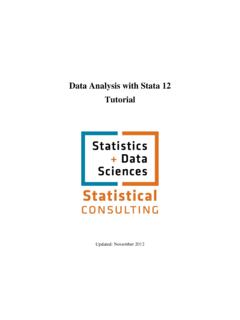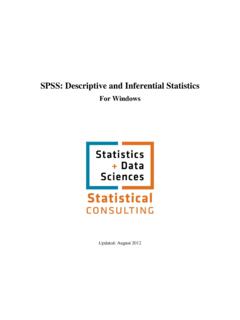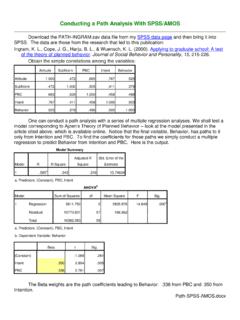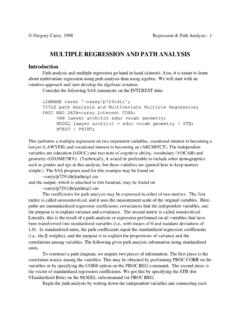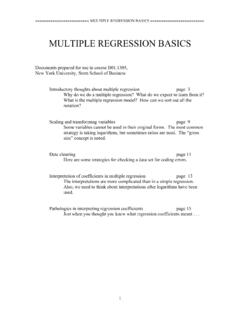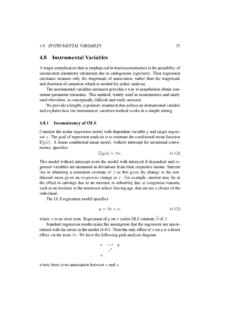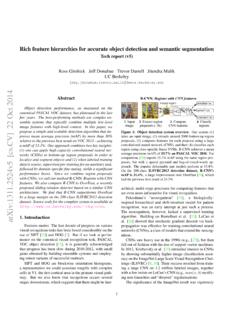Transcription of Structural Equation Modeling Using AMOS
1 Structural Equation Modeling Using amos . An Introduction August 2012. Structural Equation Modeling Using amos . Table of Contents Section 1: Introduction ..3. About this Document/Prerequisites ..3. Accessing amos ..3. Documentation ..4. Getting Help with amos ..4. Section 2: SEM Basics ..5. Overview of Structural Equation Modeling ..5. SEM Why SEM? ..8. Section 3: SEM Assumptions ..8. A Reasonable Sample Size ..8. Continuously and Normally Distributed Endogenous Variables ..9. Model Identification (Identified equations ) ..9. Complete Data or Appropriate Handling of Incomplete Data .. 13. Theoretical Basis for Model Specification and 14.
2 Section 4: Building and Testing a Model Using amos Graphics .. 15. Illustration of the SEM- multiple regression Relationship .. 15. Drawing a model Using amos Graphics .. 19. Reading Data into amos .. 26. Selecting amos analysis Options and Running your Model .. 33. Section 5: Interpreting amos Output .. 35. Evaluating Global Model Fit .. 36. Tests of Absolute Fit .. 38. Tests of Relative Fit .. 38. Modifying the Model to Obtain Superior Goodness of Fit .. 39. Viewing path Diagram Output .. 46. Significance Tests of Individual Parameters .. 49. Section 6: Putting it all together - A substantive interpretation of the findings.
3 50. References .. 51. 2. The Division of Statistics + Scientific Computation, The University of Texas at Austin Structural Equation Modeling Using amos . Section 1: Introduction About this Document/Prerequisites This course is a brief introduction and overview of Structural Equation Modeling Using the amos ( analysis of Moment Structures) software. Structural Equation Modeling (SEM). encompasses such diverse statistical techniques as path analysis , confirmatory factor analysis , causal Modeling with latent variables, and even analysis of variance and multiple linear regression . The course features an introduction to the logic of SEM, the assumptions and required input for SEM analysis , and how to perform SEM analyses Using amos .
4 By the end of the course you should be able to fit Structural Equation models Using amos . You will also gain an appreciation for the types of research questions well-suited to SEM and an overview of the assumptions underlying SEM methods. You should already know how to conduct a multiple linear regression analysis Using SAS, SPSS, or a similar general statistical software package. You should also understand how to interpret the output from a multiple linear regression analysis . Finally, you should understand basic Microsoft Windows navigation operations: opening files and folders, saving your work, recalling previously saved work, etc.
5 Accessing amos . You may access amos in one of three ways: 1. License a copy from SPSS, Inc. for your own personal computer. 2. amos is available to faculty, students, and staff at the University of Texas at Austin via the STATS Windows terminal server. To use the terminal server, you must obtain an ITS. computer account (an IF or departmental account) and then validate the account for Windows NT Services. You then download and configure client software that enables your PC, Macintosh, or UNIX workstation to connect to the terminal server. Finally, you connect to the server and launch amos by double-clicking on the amos program icon located in the STATS terminal server program group.
6 Details on how to obtain an ITS. computer account, account use charges, and downloading client software and configuration instructions may be found in 3. Download the free student version of amos from the amos development website for your own personal computer. If your models of interest are small, the free demonstration version may be sufficient to meet your needs. For larger models, you will need to purchase your own copy of amos or access the ITS shared copy of the software through the campus network. The latter option is typically more cost effective, particularly if you decide to access the other software programs available on the server ( , SAS, SPSS, HLM, Mplus, etc.)
7 3. The Division of Statistics + Scientific Computation, The University of Texas at Austin Structural Equation Modeling Using amos . Documentation The amos manual is the amos User's Guide by James Arbuckle and can be found online. It contains over twenty examples that map to models typically fitted by many investigators. These same examples, including sample data, are included with the student and commercial versions of amos , so you can easily fit and modify the models described in the amos manual. The previous amos manual is the amos User's Guide by James Arbuckle and Werner Wothke; this manual also contains numerous examples.
8 A copy of the amos User's Guide is available at the PCL for check out by faculty, students, and staff at UT Austin. Barbara Byrne has also written a book on Using amos . The title is Structural Equation Modeling with amos : Basic Concepts, Applications, and Programming. The book is published by Lawrence Erlbaum Associates, Inc. Lawrence Erlbaum Associates, Inc. also publishes the journal Structural Equation Modeling on a quarterly basis. The journal contains software reviews, empirical articles, and theoretical pieces, as well as a teacher's section and book reviews. A number of textbooks about SEM are available, ranging from Ken Bollen's encyclopedic reference book to Rick Hoyle's more applied edited volume.
9 Several commonly cited titles are shown below. Bollen, (1989). Structural equations with Latent Variables. New York: John Wiley and Sons. Loehlin, (1997). Latent Variable Models. Mahwah, NJ: Lawrence Erlbaum Associates. Hoyle, R. (1995). Structural Equation Modeling : Concepts, Issues, and Applications. Thousand Oaks, CA: Sage Publications. Hatcher, L. (1996). A Step-by-Step Approach to Using the SAS System for Factor analysis and Structural Equation Modeling . Cary, NC: SAS Institute, Inc. Getting Help with amos . If you have difficulties accessing amos on the STATS Windows terminal server, call the ITS.
10 Helpdesk at 512-475-9400 or send e-mail to If you are able to log in to the Windows NT terminal server and run amos , but have questions about how to use amos or interpret output, schedule an appointment with a statistical consultant at SSC statistical consulting or send e-mail to Important note: Both services are available to University of Texas faculty, students, and staff only. See our Web site at for more details about consulting services, as well as frequently asked questions and answers about EFA, CFA/SEM, amos , and other topics. 4. The Division of Statistics + Scientific Computation, The University of Texas at Austin Structural Equation Modeling Using amos .
